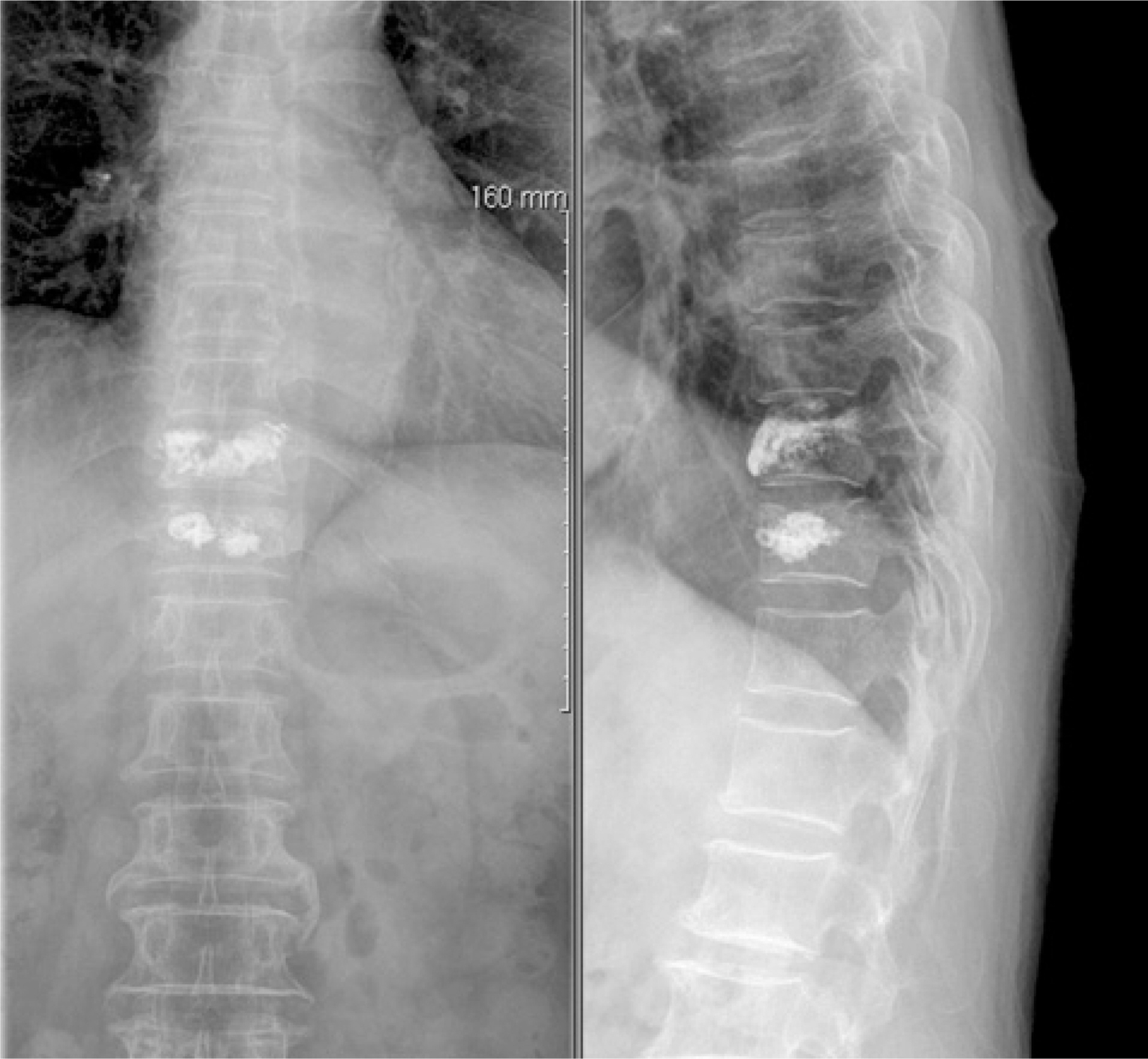J Korean Soc Spine Surg.
2009 Mar;16(1):46-49. 10.4184/jkss.2009.16.1.46.
Large Pulmonary Embolus after Percutaneous Vertebroplasty: A Case Report
- Affiliations
-
- 1Department of Orthopedic Surgery, Handong University Sunlin Hospital, Pohang, Korea.
- 2Department of Orthopedic Surgery, Wallace Memorial Baptist Hospital, Busan, Korea. msh124@paran.com
- KMID: 1473389
- DOI: http://doi.org/10.4184/jkss.2009.16.1.46
Abstract
- Percutaneous vertebroplasty for osteoporotic compression fractures or malignant osteolytic spinal tumors provides pain relief. A pulmonary embolism caused by polymethylmethacrylate migration after this procedure is rare and its major complication, pulmonary infarction, involves necrosis of the lung parenchyme, resulting from interference with the blood supply. We report a case of a large pulmonary embolus (diameter 2 cm) after cement vertebroplasty for an osteoporotic vertebral compression fracture and successful management with anticoagulation only.
MeSH Terms
Figure
Reference
-
01). Orsini EC., Byrick RJ., Mullen JB., Kay JC., Waddell JP. Cardiopulmonary function and pulmonary microemboli during arthroplasty using cemented or non-cemented components. The role of intramedullary pressure. J Bone Joint Surg Am. 1987. 69:822–832.
Article02). Padovani B., Kasriel O., Brunner P., Peretti-Viton P. Pulmonary embolism caused by acrylic cement: a rare complication of percutaneous vertebroplasty. Am J Neuroradiol. 1999. 20:375–377.03). Min SH., Kim MH., Park HG., Paik HD. A clinical analysis of 260 percutaneous vertebroplasty in the treatment of osteoporotic compression fracture. J Korean Fracture Soc. 2006. 19:357–362.
Article04). Moon SH., Kim DJ., Hwang CS., Lee SE., Park SW. A comparision of vertebroplasty versus conservative treatment in osteoporotic compression fractures. J Korean Fracture Soc. 2004. 17:374–379.05). Phillips FM., Todd Wetzel F., Lieberman I., Campbell-Hupp M. An in vivo comparison of the potential for extravertebral cement leak after vertebroplasty and kyphoplasty. Spine. 2002. 27:2173–2179.
Article06). Jang JS., Lee SH., Jung SK. Pulmonary embolism of polymethylmethacrylate after percutaneous vertebroplasty. Spine. 2002. 27:416–418.
Article07). Coventry MB., Beckenbaugh RD., Nolan DR., Ilstrup DM. 2,012 total hip arthroplasties. A study of postoperative course and early complications. J Bone Joint Surg Am. 1974. 56:273–284.08). Tozzi P., Abdelmoumene Y., Corno AF., Gersbach PA., Hoogewoud HM., von Segesser LK. Management of pulmonary embolism during acrylic vertebroplasty. Ann Thorac Surg. 2002. 74:1706–1708.
Article
- Full Text Links
- Actions
-
Cited
- CITED
-
- Close
- Share
- Similar articles
-
- Asymptomatic Pulmonary Embolus Following Percutaneous Kyphoplasty: A Case Report
- Transcatheter Removal of Bone Cement Embolism in the Right Atrium after Percutaneous Vertebroplasty: The Embolus Broke in Half and Migrated to the Right Pulmonary Artery Intraoperatively
- Pulmonary Embolism after Percutaneous Vertebroplasty with Polymethylmethacrylate: Case Report
- Asymptomatic Bone Cement Pulmonary Embolism after Percutaneous Vertebroplasty: A Case Report
- Pulmonary Embolism after Percutaneous Vertebroplasty with Polymethylmethacrylate: A case report







